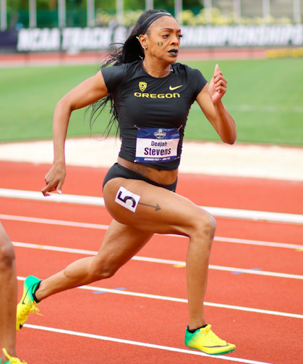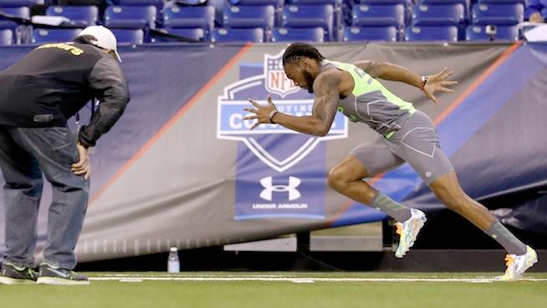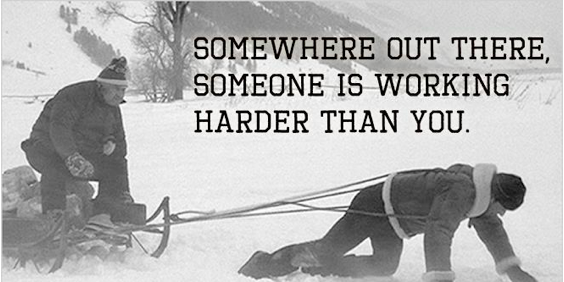In the last blog post I mentioned how the 5 tips on becoming a better coach are endless. The tips of my fingers and mind wanted me to continue! Here are tips 6-10 to go along with the last post Click here to read. For most, this list should change and evolve year by year. This isn’t an end all be all list, but should bring about discussion within your sports program or individual practice. Please share this and comment on if you disagree or agree with any of the tips. It’s a great way to see what methods others use that have been positive or negative. The only way we can continue growing our community and service those we work with is by engaging in thoughtful and respectful dialogue.
6) The top athlete on your team isn’t who you should spend most of your time with. In order to build a solid program, you have to build from the bottom up
I observe everything. I could probably make it a full-time job if I wanted to. Over the years of observing how coaches approach instructing teams and individuals, this is something that has always stuck out like a sore thumb; coaches putting all of their time and effort only into their number one player. I get it. Your number one player is often the captain, the leader, the glue that holds your team together, but in my opinion, they don’t need 100% of the attention. Delegate duties to those who can handle them and work on your team from the ground up.
One of the most common complaints parents have with athletics is their son or daughter not getting the attention needed to improve as an athlete. Word of advice to coaches: Spend more time with the athletes that need a little more attention to develop. Your team is only as good as the last guy/girl on the bench. Ignoring the athletes that aren’t as gifted says a lot about you as a coach and can have a negative impact on your program.
Now, there will be many coaches out there that say its “too hard” to help those kids that aren’t as talented. I agree and it is hard, but spending more time doesn’t always mean making them an elite athlete. Sometimes all an individual needs is to feel like they are part of the team or their hustle and consistency of showing up everyday is being recognized. This can be the difference between changing a young kids life or having them leave your hands with a bad experience. Remember, the most talented athlete on your team doesn’t need 24/7 supervision or helicopter coaching.
7) Sometimes allowing them to coach themselves is necessary
Earlier this year Steve Kerr, of the Golden State Warriors, took a step back and allowed his players to coach themselves during a game. Some viewed this as arrogant while others applauded him. I applauded him for this move. Sometimes we as coaches need take a step back and allow athletes to organize and learn on their own. This not only gives you feedback on if what you’re teaching is connecting with your group, but this also allows the players an opportunity to make adjustments without you stepping in. This can be great practice for teams needing to make adjustments on the fly during their competition.
With most athletes I coach on the private side this topic comes up often. I keep an engaging environment and I challenge athletes to talk through and figure out certain concepts I teach on their own. The last thing you want is your athlete to be overly dependent on you. Let them be students, but don’t spoon feed them.
8) Keep the environment engaging and mistake friendly
MISTAKE FRIENDLY. -Coaches, STOP yelling at your athletes for every little mistake they make. I will give you an example of the effect this has. Recently, I was at a local track working on a few sprinting concepts with an athlete. I saw a dad and his two boys practicing on their baseball skills, which is always great to see. As I took more time to observe, I noticed that any time the son would miss a ground ball or make a mistake, his dad would yell at him in disappointment. The more and more the dad yelled at his son’s mistakes, the more timid the son became. It got to the point where the son was so flustered with trying to get a ground ball that his reaction time slowed down significantly from when I first began observing.
Another example: Over the past 5 years I have had opportunities to work with various teams on the middle school and high school levels. As many coaches know, the performance or strength and conditioning coach has access to information that the team coaches don’t always get. One day I was curious to see how the athletes liked their coach yelling when they made mistakes. The majority of the athletes said that when they make a mistake and get yelled at for it, it makes them more nervous to make another mistake.
Coaches, please use these examples as an educational moment. Yes, I understand there are times we yell when angered or out of excitement, but understand that the reason your athlete’s may not be competing to the best of their ability is possibly due to the negative tone or approach you take when your athlete’s make mistakes. Sometimes, you have to address these issues with a more educational approach rather than resorting to yelling. You may feel the need to always have your voice heard, but it isn’t about you.
From experience, yelling doesn’t work for my style of coaching. If I have an athlete make a mistake, I use the mistake to educate them instead of yelling at them. A few months ago I had an athlete miss their running event at a track meet. I was frustrated because twenty to thirty minutes prior to that incident, I reminded the team to pay attention to when their events are called. Rather than blowing a vein in my forehead, I educated that athlete on the importance of taking responsibility. That athlete was disappointed and felt guilty for missing the event, so yelling or shaming wasn’t necessary. Most athletes know and understand their mistakes and try their best to learn from them. Yelling, in my opinion, adds more anxiety and an increased chance of the same mistake happening again.
9) Learn how to read body language and energy
A must. A must. A must. This by far is one of the most valuable t assets I’ve been blessed to have in my coaching toolbox. I work with many middle school and high school kids on the private side, and coach a high school boy’s and girl’s track team. I deal with a number of personalities, backgrounds, and levels of athleticism. Why is this information important? It’s important to illustrate the various numbers of athletes I work with and importance of being able to read body language and facial expressions. Not having this asset in some regards would make coaching difficult. There are times when I have had teams show up to practice and as soon as they walked through the door, I could feel their energy. I have athletes show up for individual lessons and I can tell what type of energy they are going to have for the session based off of the way they walk and tone of their voice.
I like to joke with many of my athletes and tell them I work for the CIA because of my keen detective skills. All jokes aside, this isn’t something you are taught when you decide to test the waters of coaching athletes. I believe it’s all about a coach taking the time to observe each individual, having general knowledge about human behavior, and truly understand what it means to be a coach. The book Conscious Coaching by Brett Bartholomew is also a great resource to have. These tools will slowly give you a better understanding and help you determine the approach to take when coaching your team. Over time, you will be able to assess and judge how your teams act after a win, tough loss, or a week full of final exams. Learning energies and body language isn’t hard. It just takes a coach willing enough to pay attention to his or her athletes to become good at it.
10) Let it be known that you have an open door policy. Being a “hardass” sometimes scares athletes away from opening up to you.
Last but not least, keep an open door policy. This goes back to communicating and doing it well. I can’t tell you how many times some of my athletes have come to me to talk about a private topic. Some topics have caused me to lose sleep at night, but that is part of being a coach. Some believe this is crossing the line or that coaches shouldn’t open the doors to athletes that have tough topics to discuss. I completely disagree. Sometimes a coach is all an athlete may have or the only person they are comfortable talking to. No, the role of “therapist” doesn’t fall under the category of coaching, but sometimes those are the cards we are dealt. Side note: (Never try to diagnose an athlete or get yourself involved in family or legal issues your athlete may have. Be extremely supportive, but let professionals handle those types of situations). Not comfortable talking to athletes about tough topics? Delegate and get that student athlete what he or she needs. The last thing you want to do is scare an athlete by your inability to stay calm and relaxed when certain topics come up. It will eventually happen, so be prepared and know what you need to do.
In closing, I hope these tips and topics have made you think more on what being a coach is all about. We aren’t perfect and this list WILL NOT automatically make you a better coach. This list is intended to help you along your journey of eventually becoming a better coach. I don’t consider myself a seasoned veteran by any means, but I know the approach I take with coaching has been extremely rewarding and successful.
______________________________________________________________________________
 Kendrique Coats is the owner of Coats Performance, which provides speed and agility training in Frisco, Texas and surrounding areas. Over the years, Coats has spent most of his coaching time on the high school level coaching boys and girls track and field as well as overseeing strength and conditioning programs, which included stops at Pontiac Township High School in Illinois and Bloomington-Normal, Illinois. Now the head track and field coach at Dallas International School in Dallas, Texas, Coats looks to bring many of his training and coaching philosophies to the new program. Coats has written several articles including “Why I Stopped Yelling and Started Coachingalong with Early Sports Specialization. For more on Coach Coats and his work, be sure to follow on Twitter @kendriquecoats, Instagram @CoatsPerformance, and his website www.coatsperformance.com. You can also connect with Coach Coats via email at kcoats@coatsperformance.com
Kendrique Coats is the owner of Coats Performance, which provides speed and agility training in Frisco, Texas and surrounding areas. Over the years, Coats has spent most of his coaching time on the high school level coaching boys and girls track and field as well as overseeing strength and conditioning programs, which included stops at Pontiac Township High School in Illinois and Bloomington-Normal, Illinois. Now the head track and field coach at Dallas International School in Dallas, Texas, Coats looks to bring many of his training and coaching philosophies to the new program. Coats has written several articles including “Why I Stopped Yelling and Started Coachingalong with Early Sports Specialization. For more on Coach Coats and his work, be sure to follow on Twitter @kendriquecoats, Instagram @CoatsPerformance, and his website www.coatsperformance.com. You can also connect with Coach Coats via email at kcoats@coatsperformance.com


 I took this picture at the NCAA Track & Field Championships. Deajah Stevens is sprinting, not running.
I took this picture at the NCAA Track & Field Championships. Deajah Stevens is sprinting, not running. Bodybuilding will make you slower. This guy looks good in the mirror but his strength is non-functional.
Bodybuilding will make you slower. This guy looks good in the mirror but his strength is non-functional. Last season I coached the fastest 14 year-old in the nation, Marcellus Moore, #1 IL indoors in the 60m (6.86) and 200m (21.95). #2 IL 100m (10.41), #1 IL 200m (21.28). Marcellus did not get fast by lifting weights or surviving high volume workouts.
Last season I coached the fastest 14 year-old in the nation, Marcellus Moore, #1 IL indoors in the 60m (6.86) and 200m (21.95). #2 IL 100m (10.41), #1 IL 200m (21.28). Marcellus did not get fast by lifting weights or surviving high volume workouts. Slow people complain about the use of the 40 as a metric of football athleticism but the data is strong. Among the best football players entering the
Slow people complain about the use of the 40 as a metric of football athleticism but the data is strong. Among the best football players entering the  Hard work does not improve speed.
Hard work does not improve speed. Maybe this makes a Marine tougher, but it doesn’t make him faster.
Maybe this makes a Marine tougher, but it doesn’t make him faster.